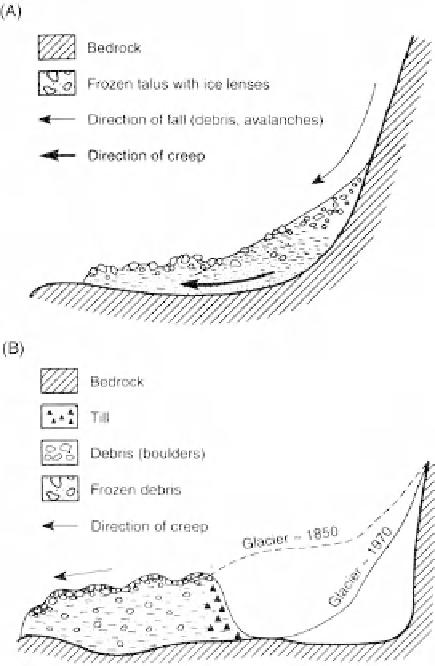Geology Reference
In-Depth Information
Figure 6.10.
Types of rock glaciers. (A) Talus-derived rock glaciers are formed beneath scree
slopes and are composed of frozen ice-cemented debris. They move by creep and deformation of
the ice-rich rock debris. (B) Debris-derived rock glaciers form below glaciers and consist of a core
of glacier ice overlain and subsequently buried beneath ablation till. They are regarded as simple
debris-covered extensions to a glacier. Confusion arises when a buried body of glacier ice creeps
and deforms, producing a feature similar to a permafrost (i.e. periglacial) rock glacier. From Barsch
(1988). Reproduced by permission of John Wiley & Sons Ltd.
a core of pure glacier ice should have P-wave velocities of about 3600 m/sec. Observations
such as these, and those made by co-workers elsewhere (e.g. King, 1986), led Barsch (1988,
p. 79) to conclude that “the evidence to date fails to support the views that rock glaciers
are debris-covered glaciers.”
Rock glaciers continue to attract detailed study. No attempt is made to summarize these
investigations except to say that they fall into two broad categories. First, rock glaciers are
being used as a possible means of inferring the lower climatic and altitudinal limits of
either present or past permafrost (Hauck et al., 2004; Hauck and Vonder Muhll, 2003;
Humlum, 1998a, 1999; Whalley and Martin, 1994). Second, rock glaciers are being studied
to better understand the creep and deformation of ice-rich permafrost bodies (Kaab and
Reichmuth, 2005; Lambiel and Delaloye, 2004; Odegard et al., 2003). Methods include
detailed fi eld monitoring and geodetic surveys, geoelectrical measurements using DC
resistivity and ground-penetrating radar, and the application of high-resolution digital-
elevation models using advanced photogrammetric techniques (Hanson and Hoelzle,

